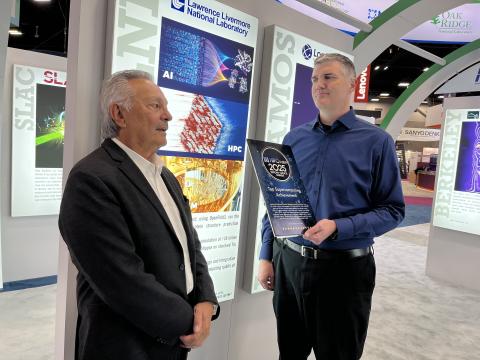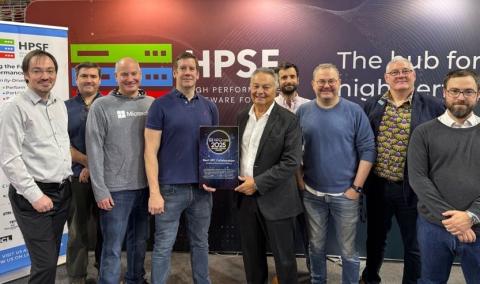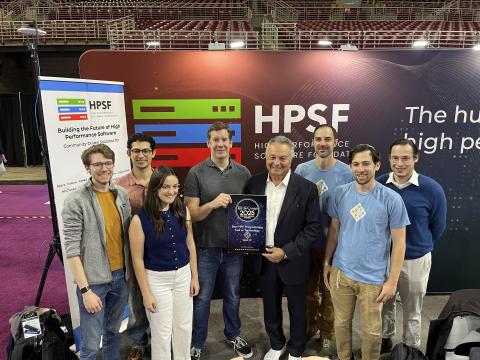At the International Conference for High Performance Computing, Networking, Storage, and Analysis conference (SC25) in St. Louis, Lawrence Livermore National Laboratory (LLNL) earned multiple top honors across exascale computing, open-source software and real-world scientific applications, receiving four 2025 HPCwire awards and a Hyperion Research HPC Innovation Excellence Award. Two of the awards recognized LLNL and collaborators’ real-time tsunami forecasting research performed on El Capitan, which again retained its title as world’s fastest supercomputer at the conference.

The recognitions highlight both the Lab’s leadership in exascale system development and the impact of its scientific computing work. El Capitan earned HPCwire’s top honors for system performance and architecture, while LLNL’s real-time tsunami forecasting digital twin — developed with partners at the University of Texas at Austin’s Oden Institute (UT)and the Scripps Institution of Oceanography at the University of California San Diego (Scripps) — received separate awards from HPCwire for Best Use of HPC in Physical Sciences and from Hyperion Research for HPC Innovation Excellence.
HPCwire’s Editor’s Choice award for Top Supercomputing Achievement recognized the launch of LLNL’s El Capitan. Deployed as the first exascale supercomputer for the National Nuclear Security Administration (NNSA), El Capitan debuted at No. 1 on the Top500 List in Nov. 2024, reaching an unprecedented 1.742 exaFLOPs on the High Performance Linpack (HPL) benchmark, and achieved a rare “triple crown” on both the June and Nov. 2025 Top500 lists, upping the machine’s HPL score to 1.809 exaFLOPs on the latest list. Besides once again topping the HPL, El Capitan also placed first on the organization’s High Performance Conjugate Gradients (HPCG) and HPL-Mixed Precision (MxP) benchmarks, reflecting its unmatched performance across both traditional and AI workloads.

Built with HPE Cray EX architecture and over 46,000 AMD InstinctTM MI300A Advanced Processing Units (APUs), the system has a peak performance of 2.88 exaFLOPs. El Capitan was funded by the NNSA’s Advanced Simulation & Computing (ASC) program.
“El Capitan's speed, scale and efficiency are a major step change for ASC's national security mission, as well as the related basic science of the program," said Bronis R. de Supinski, chief technology officer for Livermore Computing. "This award recognizes not only a historic computing milestone, but the real-world impact that it enables."
In addition to winning the coveted Association for Computing Machinery Gordon Bell Prize at SC25, LLNL and collaborators at UT and Scripps also received the Readers’ Choice award for Best Use of HPC in Physical Sciences for their real-time tsunami forecasting digital twin. Running on El Capitan, simulations based on LLNL’s open source MFEM finite element library help transform ocean-floor pressure data into localized forecasts in under 0.2 seconds—roughly 10 billion times faster than conventional methods—reducing false alarms and enabling rapid warnings.
The tsunami forecasting effort also earned a 2025 Hyperion Research HPC Innovation Excellence Award for the Outstanding Application of HPC for Business and Scientific Achievements. Hyperion’s award recognizes only a small number of global projects each year that demonstrate outstanding, HPC-enabled innovations with clear potential to benefit humanity. The collaboration was honored for pioneering a real-time, physics-based forecasting approach that may significantly improve early-warning systems for coastal communities.
“We are really honored to win these awards from HPCwire and Hyperion," said Tzanio Kolev, LLNL computational mathematician and co-author of the study. "Our goal was to show that physics-based simulation can deliver real-time results for critical applications like tsunami warnings. Achieving this kind of responsiveness with the help of El Capitan shows that exascale computing and GPU-accelerated MFEM algorithms could contribute to saving lives.”

The 2025 HPCwire awards also highlighted LLNL’s leadership in collaborative software for HPC. For the third consecutive year, the open-source package manager Spack won the Editors’ Choice Award for Best HPC Programming Tool or Technology for its latest version 1.0, released earlier this year. Used at supercomputing centers worldwide, Spack was created by LLNL computer scientist Todd Gamblin, and simplifies building, deploying and maintaining thousands of scientific applications. Spack is now maintained by Gamblin, his team, and a large community of external contributors. Spack 1.0 also marks a major stability and reproducibility milestone, introducing long-term support releases and enhanced binary distribution features that make HPC software environments more consistent and portable across systems.
“Spack 1.0 is a huge milestone for our community,” Gamblin said. “We’ve been working towards these changes for over five years, and we’ve finally been able to merge them and to provide a stable package API. This will serve as the foundation for the next decade of reliable and reproducible HPC software development.”

Finally, the Readers’ Choice Award for Best HPC Collaboration recognized the open source community’s work under the High Performance Software Foundation (HPSF), a neutral consortium for stewardship and coordination of key open source HPC projects. Gamblin co-founded HPSF along with collaborators from other national laboratories, industry and academia.
Many LLNL and Department of Energy scientists play key roles in the HPSF, and Spack is one of the core projects being further developed under the HPSF umbrella. HPSF has built technical and governance frameworks for projects, established working groups around Continuous Integration/Continuous Delivery and benchmarking, and hosted the inaugural HPSF Conference (HPSFCon) in 2025, which attracted over 200 attendees. HPSFCon 2026 will take place March 16-20, 2026.
“HPSF is an effort to make it easier for any HPC open source project to work in the open and to build their community," Gamblin said. “By building software together, and by opening communication channels among projects, we ensure that the tools enabling scientific discovery remain sustainable and accessible to all.”
The annual HPCwire Readers’ and Editors’ Choice Awards are determined through a nomination and voting process with the global HPCwire community and editorial panel. For more, visit https://www.hpcwire.com/.

